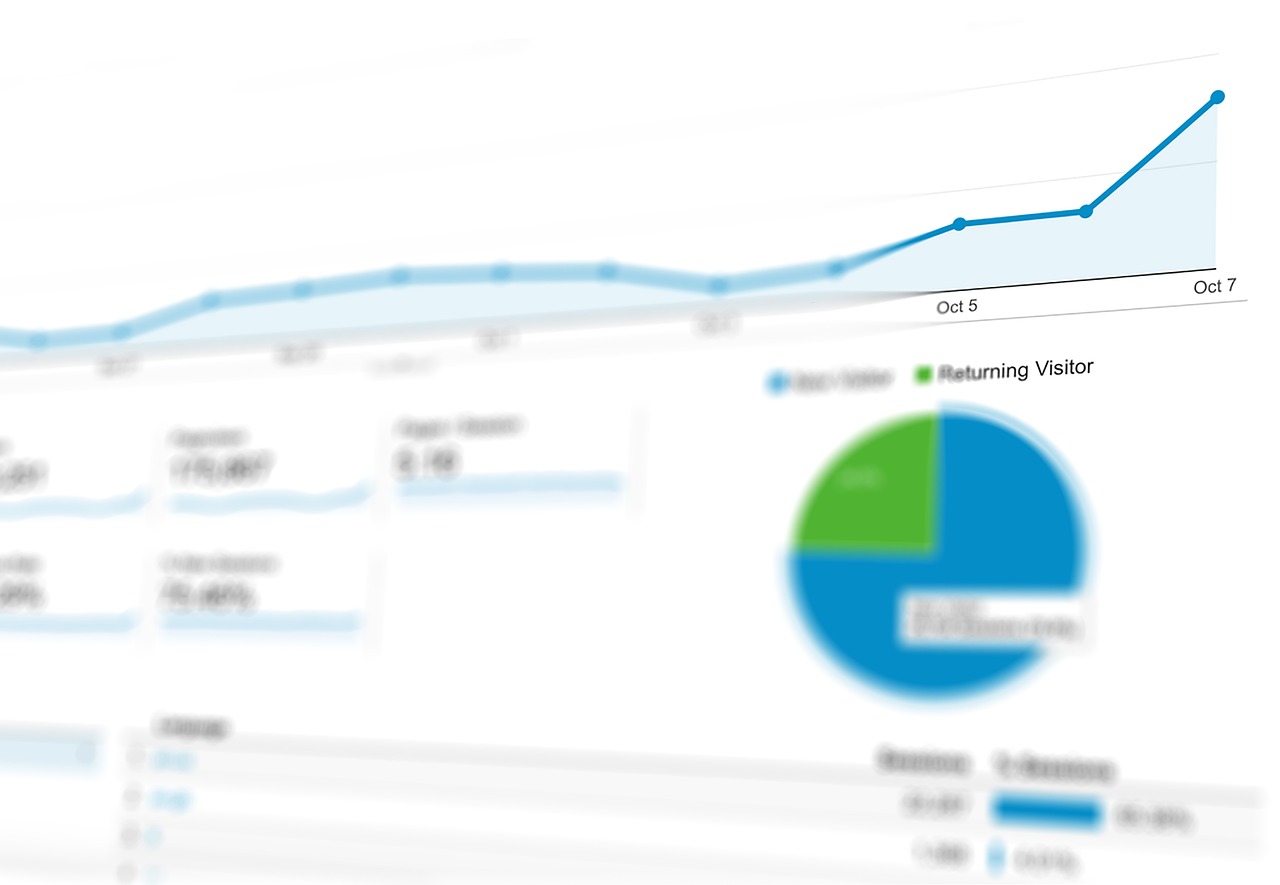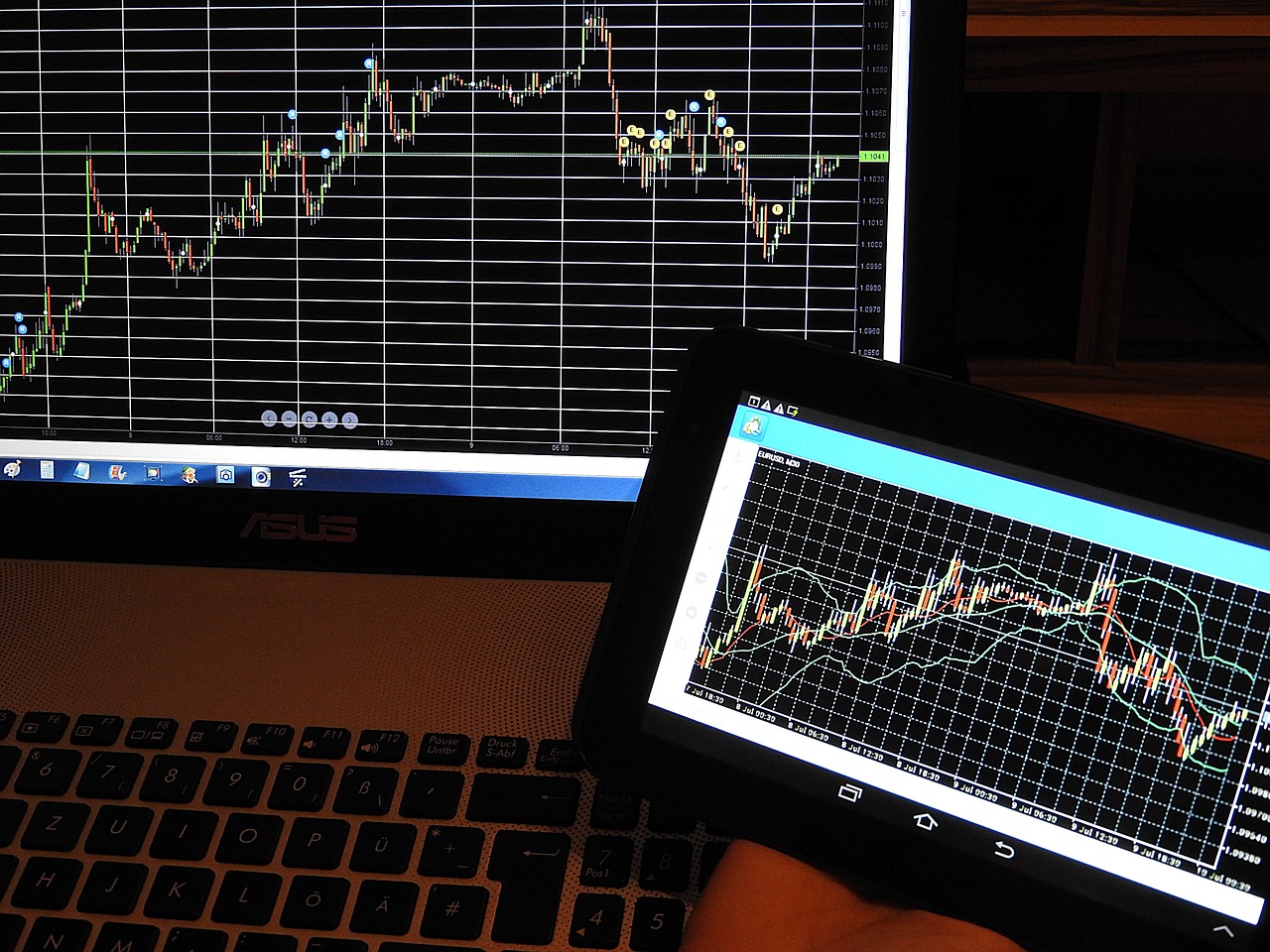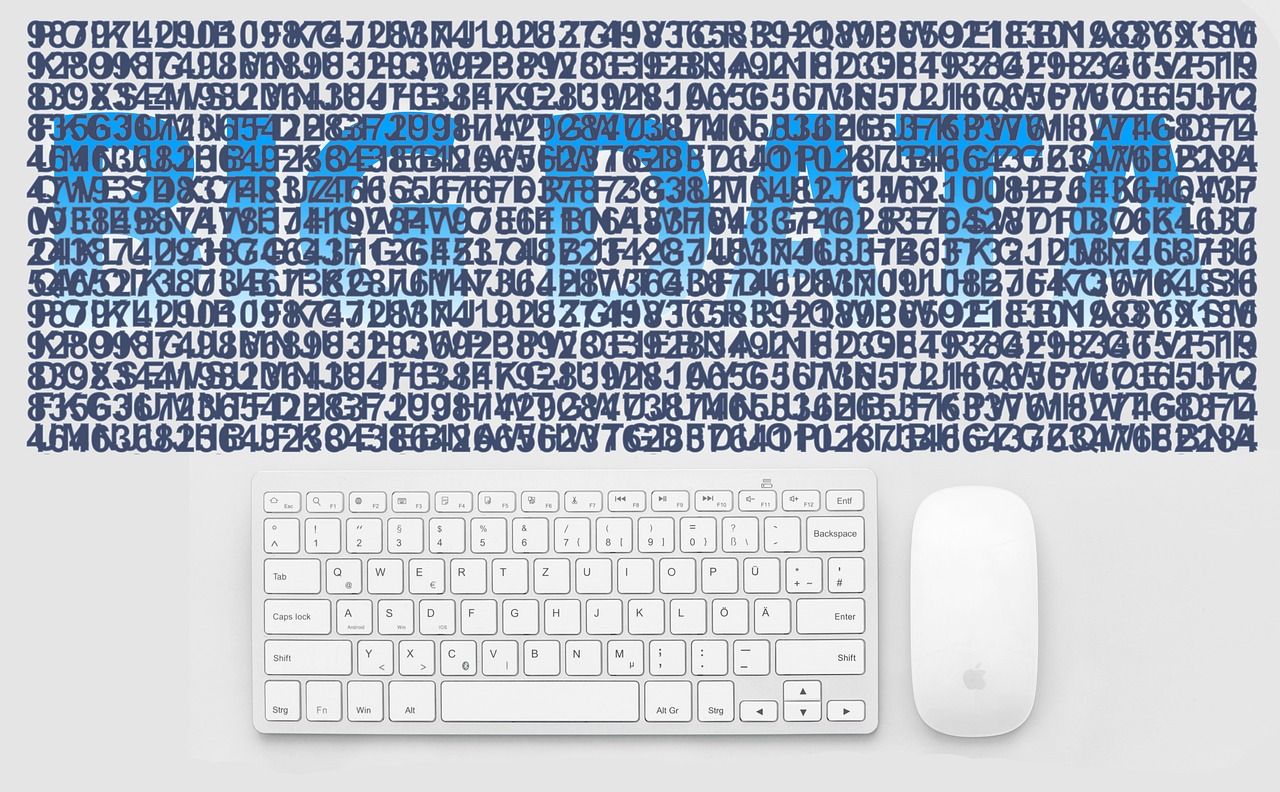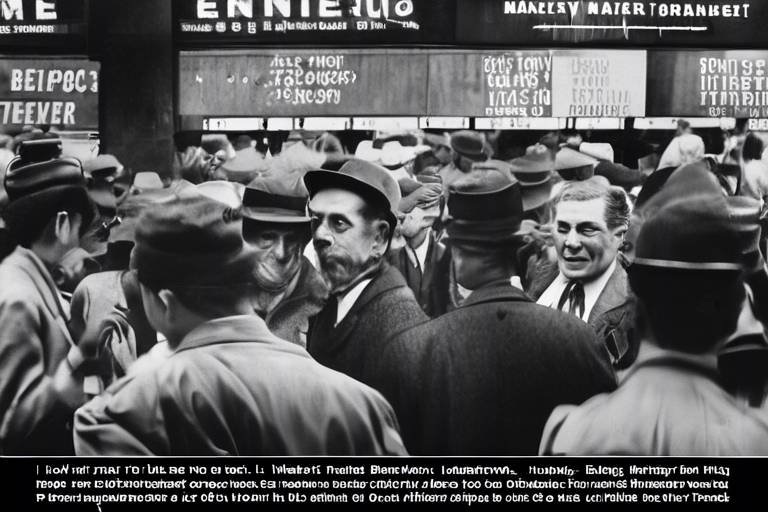How to Use Historical Data for Market Predictions
In the fast-paced world of finance, where every second counts and the stakes are high, understanding how to leverage historical data for market predictions can be your secret weapon. Imagine trying to navigate a stormy sea without a compass; that’s what trading can feel like without the insights provided by historical data. By analyzing past market behaviors, investors and analysts can uncover valuable trends and patterns that serve as a roadmap for future market movements. This article dives deep into the methodologies, tools, and strategies that can significantly enhance forecasting accuracy, helping you make informed decisions in a sea of uncertainty.
Understanding the significance of historical data is crucial for market predictions. It acts as a foundation for analysis, revealing trends and patterns that can inform future market behavior. Think of historical data as the footprints left in the sand; they tell a story of where the market has been and can provide clues about where it might go next. By studying these footprints, you can gain insights into how similar conditions have affected market movements in the past, which is invaluable for making educated guesses about the future.
Various types of historical data exist, each offering unique insights that can be leveraged for more accurate predictions. The most common types include:
- Price Data: This includes the historical prices of assets, which is fundamental for traders looking to identify trends and potential future price actions.
- Volume Data: This indicates how much of an asset was traded over a specific time period, providing insights into the strength of price movements.
- Economic Indicators: These are statistics about economic activities that can influence market behavior, such as unemployment rates, GDP growth, and inflation rates.
Price data analysis involves examining past price movements to identify trends and potential future price actions. This technique is essential for traders looking to make informed decisions. Think of it like reading the weather forecast based on past climate patterns; it helps you anticipate what might happen next. By analyzing historical price data, traders can spot support and resistance levels, which are critical in determining entry and exit points for trades.
Technical indicators, derived from historical price data, help traders assess market trends and potential reversals. Popular indicators include moving averages and the Relative Strength Index (RSI). These tools act like a magnifying glass, allowing traders to zoom in on specific data points and make sense of the noise in the market. For example, when a short-term moving average crosses above a long-term moving average, it may signal a bullish trend, prompting traders to consider buying.
Chart patterns, such as head and shoulders or double tops, emerge from historical price data. Recognizing these patterns can signal upcoming market movements and trading opportunities. Just like a seasoned detective reads clues at a crime scene, experienced traders can interpret these patterns to forecast potential price movements. For instance, a head and shoulders pattern often indicates a reversal from bullish to bearish, alerting traders to potential selling opportunities.
Volume data provides insights into the strength of price movements. Analyzing volume alongside price changes can enhance prediction accuracy, indicating whether trends are likely to continue or reverse. Think of volume as the crowd's reaction at a concert; if the crowd is roaring, the energy is high, and the performance is likely to continue. Conversely, low volume during a price increase may suggest a lack of conviction, indicating that the trend could soon reverse.
Numerous tools are available for analyzing historical data, ranging from software platforms to online resources. These tools facilitate data collection, visualization, and interpretation for better market predictions. Using the right tools is like equipping yourself with the best gear for a hike; it makes the journey smoother and more efficient.
Data visualization software enables users to create graphs and charts, making it easier to identify trends and patterns within historical data. Popular tools include Tableau and Microsoft Excel. These tools help transform raw data into visually appealing formats that can highlight important trends at a glance, making it easier for analysts to communicate their findings.
Statistical analysis tools, such as R and Python, allow for deeper analysis of historical data. These tools help in applying complex algorithms and models to enhance prediction accuracy. Just as a chef uses various ingredients to create a gourmet dish, analysts can combine different data sets and statistical methods to derive meaningful insights that drive their market predictions.
Integrating historical data with current market trends is vital for accurate predictions. This approach allows analysts to adjust their forecasts based on recent developments and market dynamics. It’s like tuning a musical instrument; you need to ensure that everything is aligned to create the perfect harmony. By blending historical insights with current events, analysts can refine their predictions and make them more relevant to today’s market conditions.
Recognizing market cycles through historical data can aid in predicting future market movements. Understanding these cycles helps investors time their entries and exits more effectively. Just as seasons change, markets go through cycles of growth and decline. By identifying where the market currently stands in its cycle, investors can make strategic decisions that align with the prevailing trend.
Current events can significantly impact market behavior. Adjusting predictions based on recent news and developments ensures that forecasts remain relevant and accurate in a dynamic market environment. Think of it as being a weather forecaster; while historical data is important, unexpected storms can change everything in an instant. Staying informed about current events allows analysts to adapt their strategies and remain ahead of the curve.
Q: How can I start using historical data for market predictions?
A: Begin by collecting relevant historical data for the assets you are interested in. Use tools like Excel or specialized software to analyze trends and patterns.
Q: What types of historical data should I focus on?
A: Focus on price data, volume data, and relevant economic indicators. Each type provides unique insights that can enhance your predictions.
Q: Are there any free tools for analyzing historical data?
A: Yes, there are several free tools available, including Google Sheets, Yahoo Finance, and various online charting platforms.
Q: How often should I update my historical data analysis?
A: Regularly updating your analysis is crucial, especially after significant market events or changes in economic conditions. Staying current ensures your predictions remain accurate.

The Importance of Historical Data
Understanding the significance of historical data is crucial for making informed market predictions. Just like a seasoned sailor uses the stars to navigate the seas, investors and analysts rely on past data to guide their decisions. Historical data provides a solid foundation for analysis, revealing trends and patterns that can inform future market behavior. It’s not just a collection of numbers; it’s a treasure trove of insights waiting to be uncovered.
Imagine trying to predict the weather without knowing what the climate has been like in previous years. You’d be shooting in the dark! Similarly, historical data allows us to see how markets have reacted to certain events, helping us to anticipate potential future movements. By examining past performances, we can identify recurring patterns that may indicate how the market will behave under similar circumstances.
Moreover, historical data can help investors understand the volatility of a market. For example, during economic downturns, certain stocks may consistently perform poorly. By analyzing this data, investors can make more informed choices about where to place their money. In a way, it’s like having a map that highlights the rocky terrains and safe passages, helping you navigate the investment landscape more effectively.
To illustrate the importance of historical data, let’s consider a few key aspects:
- Trend Analysis: By studying historical price movements, analysts can identify long-term trends that may continue into the future.
- Risk Assessment: Historical data allows investors to gauge the risks associated with specific investments, helping them to make better choices.
- Performance Benchmarking: Investors can compare current market conditions with historical performance to assess whether an asset is overvalued or undervalued.
In summary, historical data is not just a tool; it’s a vital component of successful market predictions. By leveraging this data effectively, analysts and investors can enhance their forecasting accuracy, making them better equipped to navigate the unpredictable waters of the financial markets.
- What is historical data? Historical data refers to past market data, including price movements, trading volumes, and economic indicators, which can be analyzed to predict future market trends.
- Why is historical data important for market predictions? It helps identify trends, assess risks, and benchmark performance, providing a foundation for informed decision-making.
- How can I access historical market data? Historical market data can be accessed through various platforms, including financial news websites, stock market apps, and specialized data providers.

Types of Historical Data
When diving into the world of market predictions, understanding the available is crucial. Each type serves as a unique lens through which we can analyze market trends and behaviors. Let's explore some of the most significant categories of historical data that investors and analysts utilize to enhance their forecasting accuracy.
First and foremost, we have price data. This is perhaps the most straightforward yet vital type of historical data. Price data includes the historical prices of assets, such as stocks, commodities, or currencies, over a specified period. By analyzing this data, traders can identify patterns, trends, and potential future movements. For instance, if a stock consistently rises after a certain price point, traders might see this as a buying opportunity. Price data often gets visualized through charts, making it easier to spot these trends at a glance.
Next, let's talk about volume data. Volume data tracks the number of shares or contracts traded during a specific timeframe. This data is essential because it provides insight into the strength or weakness of price movements. For example, if a stock price rises significantly but the volume is low, it may indicate a lack of conviction in that price movement. Conversely, a price increase accompanied by high volume may suggest strong interest and a likely continuation of the trend. Thus, volume data is a critical component in confirming price movements.
Another type to consider is economic indicators. These are statistics that provide insight into the overall health of an economy and can significantly influence market trends. Economic indicators include metrics such as GDP growth rates, unemployment rates, inflation rates, and consumer confidence indices. Investors often analyze these indicators to gauge the economic environment and make informed predictions about market behavior. For instance, a sudden spike in unemployment could lead to a downturn in the stock market, while an increase in consumer spending might signal growth.
To illustrate the differences among these types of historical data, we can summarize them in the following table:
| Type of Data | Description | Importance |
|---|---|---|
| Price Data | Historical prices of assets over time | Helps identify trends and patterns |
| Volume Data | Number of shares or contracts traded | Indicates strength of price movements |
| Economic Indicators | Statistics reflecting economic health | Guides predictions based on macroeconomic conditions |
In addition to these primary types, there are also sentiment data and news data. Sentiment data reflects the overall attitude of investors towards a particular asset or market, often gauged through surveys or social media analysis. News data encompasses relevant news articles, press releases, and other media that can influence market behavior. Both sentiment and news data can provide context to the price and volume data, enriching the analysis and enhancing prediction accuracy.
Ultimately, understanding the various types of historical data allows investors and analysts to create a more comprehensive picture of market dynamics. By leveraging price data, volume data, economic indicators, and beyond, they can formulate predictions that are not only informed but also adaptable to changing market conditions.
- Why is historical data important for market predictions? Historical data provides a foundation for analyzing trends, helping to forecast future market behavior.
- What types of historical data should I focus on? Focus on price data, volume data, and economic indicators, as they offer critical insights into market trends.
- How can I analyze historical data effectively? Utilize data visualization software and statistical analysis tools to uncover patterns and enhance prediction accuracy.

Price Data Analysis
When it comes to understanding market behavior, stands as a cornerstone. Think of it as reading the pulse of the market; by examining past price movements, traders can identify trends that might just give them a competitive edge. This analysis isn’t just about looking at numbers; it’s about deciphering the story those numbers tell. Have you ever noticed how a detective pieces together clues to solve a mystery? That's what traders do with price data—they connect the dots to predict future price actions.
One of the most effective ways to conduct price data analysis is through the use of technical indicators. These indicators are like signposts on a long road trip, guiding traders toward potential market trends and reversals. For instance, moving averages smooth out price fluctuations, allowing traders to see the underlying trend more clearly. Similarly, the Relative Strength Index (RSI) can signal whether a stock is overbought or oversold, helping traders make informed decisions about when to buy or sell.
Moreover, chart patterns derived from historical price data can be incredibly insightful. Patterns such as head and shoulders or double tops are not just random shapes; they represent the psychology of market participants. Recognizing these patterns can signal potential market movements, creating opportunities for savvy traders. Just like how a skilled chef knows when to flip a pancake by the bubbles that form on the surface, a trader can anticipate market movements by understanding these patterns.
To illustrate the significance of price data analysis, consider the following table that compares different technical indicators and their uses:
| Technical Indicator | Purpose | How to Use |
|---|---|---|
| Moving Averages | Identify trends | Look for crossovers to signal buying or selling opportunities |
| Relative Strength Index (RSI) | Determine overbought or oversold conditions | Use values above 70 for overbought and below 30 for oversold |
| Bollinger Bands | Assess volatility | Watch for price touching the bands to signal potential reversals |
In conclusion, price data analysis is an essential tool for traders looking to navigate the often turbulent waters of the financial markets. By understanding past price movements through various indicators and patterns, traders can make more informed decisions that enhance their chances of success. Remember, the market is like a vast ocean; those who can read the waves of historical data are better equipped to sail smoothly through the storm.
- What is price data analysis? Price data analysis involves examining historical price movements to identify trends and potential future price actions.
- Why are technical indicators important? Technical indicators help traders assess market trends and potential reversals, making them crucial for informed decision-making.
- How can I start analyzing price data? Begin by familiarizing yourself with various technical indicators and practice using them on historical price charts.
- What are chart patterns? Chart patterns are formations created by historical price movements that can signal potential market movements.

Technical Indicators
When it comes to making informed trading decisions, play a pivotal role. These indicators are mathematical calculations based on historical price and volume data, and they help traders assess the strength of trends, identify potential reversals, and optimize their entry and exit points. Imagine trying to navigate through a dense fog without a compass; technical indicators serve as that compass, guiding traders through the often turbulent waters of the financial markets.
There are various types of technical indicators, each serving a unique purpose. For instance, moving averages smooth out price data to create a trend-following indicator that helps traders identify the direction of the market. On the other hand, the Relative Strength Index (RSI) measures the speed and change of price movements, indicating overbought or oversold conditions. This can be crucial for investors looking to time their trades effectively.
To illustrate the importance of these indicators, consider the following table that outlines some popular technical indicators along with their primary functions:
| Indicator | Type | Purpose |
|---|---|---|
| Moving Average | Trend Indicator | Identifies the direction of the trend over a specified period. |
| Relative Strength Index (RSI) | Momentum Indicator | Indicates overbought or oversold conditions in the market. |
| Bollinger Bands | Volatility Indicator | Measures market volatility and identifies potential price reversals. |
| MACD (Moving Average Convergence Divergence) | Trend and Momentum Indicator | Identifies changes in the strength, direction, momentum, and duration of a trend. |
Understanding how to effectively utilize these indicators can significantly enhance your trading strategy. For example, combining the RSI with moving averages can provide a more comprehensive view of market conditions. If the RSI indicates that an asset is overbought while the moving average shows a strong upward trend, it might suggest that a correction is imminent, prompting traders to consider their positions carefully.
Moreover, it’s important to remember that no single indicator is foolproof. The market is influenced by numerous factors, and relying solely on technical indicators can lead to misjudgments. Therefore, it’s advisable to use a combination of indicators and other analysis methods to develop a well-rounded trading strategy.
In conclusion, technical indicators are invaluable tools in the arsenal of any trader. By understanding their functions and how to apply them, investors can make more informed decisions and navigate the complexities of the market with greater confidence.
- What are technical indicators?
Technical indicators are mathematical calculations based on historical price and volume data that help traders assess market trends and potential price movements. - How do I choose the right technical indicators?
Choosing the right indicators depends on your trading style and objectives. Experiment with different indicators to find the combination that works best for you. - Can technical indicators guarantee profits?
No, technical indicators do not guarantee profits. They are tools that can help inform your trading decisions, but they should be used in conjunction with other analysis methods.

Chart Patterns
Chart patterns are fascinating formations that emerge from the historical price data of assets, serving as visual representations of market psychology and trader behavior. These patterns can be likened to the fingerprints of the market, unique yet predictable, allowing traders to anticipate future price movements based on past trends. By recognizing these formations, traders can gain valuable insights into potential reversals or continuations in price action, making them essential tools for anyone looking to navigate the financial markets.
Among the most common chart patterns are the head and shoulders, double tops, and triangles. Each of these patterns carries specific implications for future price movements:
- Head and Shoulders: This pattern typically indicates a reversal of the current trend. It consists of three peaks: a higher peak (head) between two lower peaks (shoulders). When this pattern forms, it often signals that the price may soon decline.
- Double Tops: Similar to the head and shoulders but simpler, this pattern consists of two peaks at roughly the same price level. It suggests that the asset is struggling to break through a resistance level, indicating a potential price drop.
- Triangles: These patterns can be ascending, descending, or symmetrical. They indicate a period of consolidation before a breakout, where the price may move sharply in either direction.
Understanding these patterns is not just about recognition; it's about context. For instance, a head and shoulders pattern is more significant when it appears after a strong upward trend, as it suggests a potential reversal. Conversely, spotting a triangle during a period of low volatility can indicate that a significant price movement is imminent. Thus, the ability to interpret these patterns accurately can provide traders with a competitive edge.
Moreover, combining chart patterns with other technical indicators can enhance their predictive power. For example, if a trader identifies a double top pattern and the relative strength index (RSI) shows overbought conditions, the likelihood of a price decline increases. This synergy between different analytical tools creates a more robust trading strategy, allowing for more informed decision-making.
In conclusion, chart patterns are invaluable in the realm of market predictions. They not only reveal potential future movements but also reflect the collective emotions and actions of market participants. By mastering the art of chart pattern recognition and integrating them with other analytical methods, traders can significantly improve their forecasting accuracy and ultimately their trading success.
What are chart patterns?
Chart patterns are formations created by historical price movements in financial markets. They provide insights into potential future price behavior based on past trends.
How can I identify chart patterns?
Identifying chart patterns involves analyzing price charts for specific formations, such as head and shoulders, double tops, and triangles. Traders often use visual analysis and technical indicators to assist in this process.
Are chart patterns reliable for predictions?
While chart patterns can provide valuable insights, they are not foolproof. It's essential to consider them in conjunction with other analytical tools and market conditions to enhance prediction accuracy.
Can I use chart patterns in all markets?
Yes, chart patterns can be applied across various financial markets, including stocks, forex, and commodities. However, the effectiveness may vary depending on market conditions and the asset being analyzed.

Volume Data Insights
When delving into the world of market predictions, volume data serves as a crucial component that often gets overshadowed by price movements. Why is that? Well, volume data essentially measures the number of shares or contracts traded in a security or market during a given period. It acts as a magnifying glass, revealing the strength behind price movements. Imagine you're at a concert; the louder the crowd, the more energy in the room, right? Similarly, high trading volume signals strong interest in a stock, which can indicate whether a price movement is likely to continue or reverse.
Analyzing volume alongside price changes can provide invaluable insights. For instance, if a stock's price is rising but the volume is low, it might suggest a lack of conviction among buyers. Conversely, a price increase accompanied by high volume is often seen as a strong bullish signal. This relationship between price and volume can be illustrated in a simple table:
| Price Movement | Volume Level | Market Sentiment |
|---|---|---|
| Price Up | High | Strong Bullish |
| Price Up | Low | Weak Bullish |
| Price Down | High | Strong Bearish |
| Price Down | Low | Weak Bearish |
Additionally, volume data can help identify potential reversals. When a stock's price reaches a new high but volume decreases, it might be a signal that the upward trend is losing momentum. On the flip side, if a stock is experiencing a downward trend but volume spikes, it can indicate that sellers are becoming exhausted, potentially leading to a reversal.
Moreover, volume analysis is not just about the numbers; it’s about understanding the context. For instance, during earnings season, a sudden spike in volume can indicate that traders are reacting to news, which could lead to significant price movements. Therefore, keeping an eye on volume trends can help investors gauge market sentiment and make more informed trading decisions.
In conclusion, volume data is an essential tool in the arsenal of any trader or investor. By analyzing volume alongside price movements, one can gain a deeper understanding of market dynamics, leading to more accurate predictions. So, the next time you're analyzing a stock, don’t just focus on the price; remember to turn your attention to the volume, as it might just reveal the hidden story behind the numbers.
- What is volume data? Volume data measures the number of shares or contracts traded in a security or market during a specific period.
- Why is volume important in trading? Volume indicates the strength of price movements, helping traders to assess whether trends are likely to continue or reverse.
- How can I analyze volume data effectively? Analyze volume in conjunction with price movements and consider market context, such as news events or earnings reports.

Tools for Analyzing Historical Data
In the ever-evolving landscape of market predictions, having the right tools at your disposal can make all the difference. Analyzing historical data isn't just about gathering numbers; it's about transforming those numbers into actionable insights. Various tools can help you dive deep into the data pool, allowing you to extract meaningful trends and patterns that can significantly enhance your forecasting accuracy. From sophisticated software platforms to user-friendly online resources, the options are plentiful, and each offers unique functionalities to suit different analytical needs.
One of the most popular categories of tools for analyzing historical data is data visualization software. These tools are designed to help users create visual representations of data, making it easier to spot trends at a glance. Imagine being able to turn a sea of numbers into a beautiful graph that tells a story—this is where data visualization shines. Tools like Tableau and Microsoft Excel are widely used in the industry for this purpose. They allow users to plot historical data over time, providing a clear visual context that can reveal underlying trends that might not be immediately obvious from raw data alone.
Moreover, statistical analysis tools such as R and Python play a crucial role in the analytical process. These programming languages are equipped with libraries and packages specifically designed for data analysis, enabling users to apply complex algorithms and statistical models to their historical data. For instance, using Python's Pandas library, analysts can manipulate large datasets with ease, conducting operations like filtering, grouping, and aggregating data to uncover insights that drive better decision-making. The ability to run simulations and predictive models through these tools can elevate your analysis from basic trend observation to advanced forecasting.
To give you a clearer understanding of how these tools stack up against each other, here’s a quick comparison:
| Tool | Type | Key Features |
|---|---|---|
| Tableau | Data Visualization | Interactive dashboards, drag-and-drop interface, real-time data analysis |
| Microsoft Excel | Data Visualization & Analysis | Pivot tables, charts, formulas, extensive add-ins |
| R | Statistical Analysis | Comprehensive statistical tests, data manipulation, advanced graphics |
| Python | Statistical Analysis | Data analysis libraries (Pandas, NumPy), machine learning capabilities |
Ultimately, the choice of tools depends on your specific needs, level of expertise, and the complexity of the data you're working with. Whether you're a seasoned analyst or just starting, leveraging these tools can help you make sense of historical data, turning it into a powerful ally for your market predictions. By integrating the insights gained from these tools with your understanding of current market dynamics, you can create a robust predictive model that stands the test of time.
- What is the best tool for beginners? - For beginners, Microsoft Excel is often recommended due to its user-friendly interface and extensive online resources.
- Can I use R and Python together? - Yes, many analysts use both R and Python to leverage the strengths of each language for different aspects of their analysis.
- How do I know which tool is right for me? - It depends on your specific needs, such as the type of data you’re analyzing, your budget, and your level of expertise. Consider starting with free trials to test out different options.

Data Visualization Software
In today's fast-paced trading environment, has become an essential tool for analysts and investors alike. These platforms enable users to transform complex datasets into clear and insightful visual representations, allowing for quicker and more informed decision-making. Imagine trying to decipher a dense spreadsheet filled with numbers; it can be overwhelming! However, with the right visualization tools, those numbers can morph into intuitive graphs and charts that tell a story.
Among the myriad of options available, two standout platforms are Tableau and Microsoft Excel. Tableau is renowned for its ability to handle large datasets and create interactive dashboards, making it ideal for analysts who need to present their findings to stakeholders. On the other hand, Microsoft Excel, a staple in many offices, offers a range of charting tools that are user-friendly and versatile, perfect for those just starting with data visualization.
Let's delve deeper into the features of these tools:
| Feature | Tableau | Microsoft Excel |
|---|---|---|
| User Interface | Intuitive drag-and-drop interface | Familiar grid layout |
| Data Handling | Handles large datasets seamlessly | Limited by system memory |
| Visualization Options | Extensive range of customizable visualizations | Standard charts and graphs |
| Collaboration | Easy sharing and collaboration features | Basic sharing via files |
Using these tools, analysts can create a variety of visualizations, such as:
- Line Charts: Great for showing trends over time.
- Bar Graphs: Perfect for comparing quantities across different categories.
- Heat Maps: Useful for displaying data density and patterns.
By leveraging these visual tools, investors can spot trends that might not be immediately apparent in raw data. For instance, a simple line chart could reveal a consistent upward trend in stock prices, prompting an investor to consider buying before the price surges further. In contrast, a heat map might highlight periods of high trading volume, signaling potential market volatility.
In conclusion, incorporating data visualization software into your market analysis toolkit can significantly enhance your forecasting capabilities. By making complex data more accessible and understandable, these tools empower investors and analysts to make better, more informed decisions. So, whether you're a seasoned trader or a newcomer to the market, investing time in learning these platforms can pay off in spades.
- What is data visualization? Data visualization is the graphical representation of information and data, making it easier to identify patterns, trends, and insights.
- Why is data visualization important for market predictions? It helps in simplifying complex data, allowing analysts to quickly grasp trends and make informed decisions based on visual insights.
- What are some popular data visualization tools? Some popular tools include Tableau, Microsoft Excel, Google Data Studio, and Power BI.
- Can I use data visualization for real-time data analysis? Yes, many data visualization tools offer real-time data integration, allowing for up-to-date analysis.

Statistical Analysis Tools
When it comes to making sense of historical data, are your best friends. Think of them as the magnifying glasses that help you peer into the past and extract valuable insights that can shape your future market predictions. These tools enable analysts and investors to apply complex algorithms to historical datasets, which can lead to more precise forecasting. Among the most popular statistical analysis tools are R and Python, both of which offer extensive libraries tailored for data analysis.
R is particularly favored in the statistical community for its rich ecosystem of packages that allow for sophisticated statistical modeling. It’s like having a Swiss Army knife in your toolkit—whether you need to perform regression analysis, time series forecasting, or even machine learning, R has got you covered. On the other hand, Python is renowned for its versatility and ease of use. Thanks to libraries like Pandas and NumPy, Python makes data manipulation a breeze, allowing analysts to focus more on drawing insights rather than getting bogged down in coding syntax.
Using these tools, analysts can perform a variety of tasks, including:
- Data Cleaning: Preparing your dataset by removing inaccuracies and handling missing values.
- Descriptive Statistics: Summarizing the data to understand its basic features, such as mean, median, and standard deviation.
- Inferential Statistics: Making predictions or inferences about a population based on a sample of data.
- Time Series Analysis: Analyzing data points collected or recorded at specific time intervals to identify trends and seasonal patterns.
To illustrate the power of statistical analysis tools, let’s consider a simple example. Imagine you are analyzing stock price data over the last ten years. By using R or Python, you can create a time series model that fits the historical data and forecasts future prices. This model can incorporate various factors, such as economic indicators and market sentiment, providing a more comprehensive view of what might happen next in the market.
Moreover, the ability to visualize data is another significant advantage of these tools. With R's ggplot2 or Python's Matplotlib, you can create stunning visual representations of your data, making it easier to spot trends and anomalies at a glance. This visual aspect not only aids in analysis but also enhances presentations, allowing you to communicate your findings effectively to stakeholders.
In summary, leveraging statistical analysis tools like R and Python can significantly enhance your ability to analyze historical data. By applying these tools to your market predictions, you’re not just relying on gut feelings or surface-level insights; instead, you’re making informed decisions backed by solid data and statistical rigor. This approach can ultimately give you a competitive edge in the ever-evolving market landscape.
Q: What is the best statistical analysis tool for beginners?
A: For beginners, Python is often recommended due to its straightforward syntax and extensive resources available online. It also has a large community that can provide support and guidance.
Q: Can I use these tools for real-time data analysis?
A: Yes, both R and Python can be integrated with real-time data feeds, allowing you to perform live analysis and make timely decisions based on the most current information available.
Q: Do I need to have a strong math background to use these tools?
A: While a basic understanding of statistics is beneficial, you don’t need to be a math whiz to use R or Python. Many resources and tutorials can help you learn the necessary concepts as you go along.

Integrating Historical Data with Current Trends
Integrating historical data with current trends is not just a smart move; it's essential for anyone serious about making accurate market predictions. Think of historical data as the compass guiding you through the ever-changing landscape of market dynamics. By analyzing past behaviors, trends, and patterns, you can create a more nuanced understanding of what might happen next. But how do we blend this rich tapestry of history with the fast-paced world of today? It's all about recognizing the interplay between the two.
First and foremost, understanding market cycles is crucial. Historical data reveals the cyclical nature of markets—periods of expansion followed by contraction, much like the seasons of nature. For example, during a bull market, you might see a consistent upward trend in prices, while a bear market often showcases a decline. By identifying these cycles through historical analysis, investors can time their entries and exits more effectively. This is akin to a surfer waiting for the perfect wave; knowing when to ride the swell can make all the difference.
Moreover, adjusting predictions based on current events is a vital strategy. The market is a living organism, constantly reacting to news, economic indicators, and geopolitical events. For instance, a sudden shift in government policy or an unexpected economic report can drastically change market sentiment. By continuously updating your predictions to reflect these current developments, you ensure that your forecasts remain relevant. Imagine trying to navigate a ship without adjusting your course; you might end up far from your intended destination!
To illustrate this point, let’s take a look at a simple table that outlines how historical data can be integrated with current trends:
| Aspect | Historical Data Insights | Current Trends Adjustments |
|---|---|---|
| Market Cycles | Identifying past cycles for timing | Adjusting strategies based on current cycle phase |
| Economic Indicators | Understanding past economic impacts | Factoring in recent economic changes |
| Price Movements | Analyzing historical price trends | Reacting to current price volatility |
By using such a framework, analysts can blend the wisdom of the past with the realities of the present. It's like cooking; the right ingredients (historical data) mixed with the latest flavors (current trends) can create a dish that not only satisfies but also surprises. Remember, the goal is to create a holistic view that marries the old with the new, ensuring that your predictions are not just educated guesses but informed insights.
- Why is historical data important for market predictions?
Historical data helps identify trends and patterns that can inform future market behavior, allowing for more accurate predictions. - How can I adjust my predictions based on current events?
By staying updated on news and economic indicators, you can modify your forecasts to reflect recent developments. - What tools can I use to analyze historical data?
There are various tools available, including data visualization software like Tableau and statistical analysis tools like R and Python.

Identifying Market Cycles
Identifying market cycles is like being a detective in the world of finance. Just as a detective looks for clues to solve a mystery, investors must analyze historical data to uncover patterns and trends that signal the different phases of market cycles. These cycles typically consist of four main stages: expansion, peak, contraction, and trough. Recognizing where the market stands within this cycle is crucial for making informed investment decisions.
Market cycles can be influenced by various factors, including economic indicators, investor sentiment, and global events. For instance, during the expansion phase, the economy is growing, and businesses thrive, leading to higher stock prices. Conversely, during the contraction phase, economic downturns can result in falling prices and increased market volatility. By understanding these cycles, investors can better time their entries and exits, maximizing their potential returns.
To effectively identify market cycles, one can utilize several analytical tools and methodologies:
- Technical Analysis: This involves studying price charts and patterns to identify trends and potential reversals. Traders often look for specific formations, such as the head and shoulders or double bottoms, which can indicate a change in the market cycle.
- Economic Indicators: Key indicators, such as GDP growth rates, unemployment rates, and consumer confidence indexes, provide insights into the overall health of the economy. Tracking these indicators can help investors anticipate shifts in market cycles.
- Sentiment Analysis: Gauging investor sentiment through surveys or social media can provide clues about market psychology. High levels of optimism may signal a peak, while widespread pessimism could indicate a trough.
Moreover, it’s essential to remember that market cycles are not always predictable. They can be influenced by unexpected events, such as geopolitical tensions or natural disasters, which can disrupt established trends. Therefore, while historical data is invaluable, it’s vital to remain adaptable and responsive to current market dynamics.
In summary, identifying market cycles requires a combination of analytical skills, a keen eye for detail, and an understanding of economic fundamentals. By mastering this art, investors can position themselves strategically, ensuring they capitalize on opportunities as they arise, rather than being caught off guard by market fluctuations.
Q: How can I start identifying market cycles?
A: Begin by studying historical price charts and familiarize yourself with key economic indicators. Utilize technical analysis tools and keep an eye on market sentiment to get a holistic view of the cycles.
Q: Are market cycles always predictable?
A: While historical data can provide insights, market cycles are influenced by many unpredictable factors. It's essential to remain flexible and adjust your strategies based on current events.
Q: What role do economic indicators play in identifying market cycles?
A: Economic indicators provide critical insights into the health of the economy, helping investors gauge whether the market is in an expansion or contraction phase. Tracking these indicators can aid in making informed predictions.
Q: Can sentiment analysis really impact my investment decisions?
A: Yes! Understanding investor sentiment can give you a competitive edge. If the majority are overly optimistic, it might be a sign to be cautious, while widespread pessimism could present buying opportunities.

Adjusting Predictions Based on Current Events
In the fast-paced world of finance, it's essential to understand that current events can dramatically shift market dynamics. Just think about it: a sudden geopolitical conflict, a groundbreaking technological advancement, or an unexpected economic report can all send shockwaves through the market. This volatility underscores the importance of not only relying on historical data but also being agile enough to adjust predictions based on the latest developments.
When analysts incorporate current events into their forecasting models, they can create a more robust and realistic picture of potential market movements. For instance, if a major company announces a significant merger, historical trends might suggest a certain pattern, but the real-time impact of that news could be far more substantial. This is where the integration of qualitative data—like news articles, social media sentiment, and expert opinions—becomes invaluable.
To effectively adjust predictions based on current events, consider the following strategies:
- Stay Informed: Regularly follow reliable news sources and financial reports. Information is power, and being the first to know can give you a significant edge.
- Utilize Sentiment Analysis: Leverage tools that analyze public sentiment regarding specific stocks or the market as a whole. This can provide insights into how news is affecting investor behavior.
- Monitor Economic Indicators: Keep an eye on key economic indicators, such as unemployment rates, inflation, and consumer confidence. These factors can heavily influence market trends.
Moreover, it's crucial to develop a flexible forecasting model that can adapt to new information. For example, if you initially predicted a bullish market trend based on historical data, but then a significant economic downturn is reported, your model should allow you to adjust that prediction swiftly. This adaptability can be the difference between capitalizing on opportunities and facing significant losses.
In conclusion, while historical data provides a solid foundation for market predictions, it is the integration of current events that truly enhances forecasting accuracy. By staying informed and being ready to pivot your strategies, you can navigate the unpredictable waters of the market with greater confidence.
- Why is it important to adjust predictions based on current events?
Current events can drastically alter market conditions, making it essential to incorporate real-time data for accurate forecasts. - What types of current events should I monitor?
Focus on economic reports, geopolitical developments, corporate announcements, and significant changes in market sentiment. - How can I stay updated on current events?
Utilize reliable news outlets, financial news websites, and social media platforms to get the latest updates.
Frequently Asked Questions
- What is the significance of historical data in market predictions?
Historical data serves as a crucial foundation for market predictions. It allows analysts and investors to identify trends and patterns that can inform future market behavior. By examining past performance, one can gain insights into potential future movements, making it an invaluable tool for decision-making.
- What types of historical data should I consider for analysis?
When analyzing historical data, you should consider various types, including price data, volume data, and economic indicators. Each of these data types provides unique insights that can enhance your predictive accuracy. For instance, price data helps identify trends, while volume data indicates the strength of those trends.
- How can I analyze price data effectively?
To analyze price data effectively, you can utilize techniques such as studying technical indicators and recognizing chart patterns. Technical indicators like moving averages and the relative strength index (RSI) can help assess market trends, while chart patterns like head and shoulders reveal potential price movements.
- What tools are available for analyzing historical data?
There are numerous tools available for analyzing historical data, including data visualization software like Tableau and Microsoft Excel, as well as statistical analysis tools such as R and Python. These tools can help you collect, visualize, and interpret data more effectively, leading to better market predictions.
- How do I integrate historical data with current market trends?
Integrating historical data with current market trends involves recognizing market cycles and adjusting predictions based on recent events. By understanding how past cycles influence current behavior, you can make more accurate forecasts and adapt your strategies accordingly.
- Can current events affect my market predictions?
Absolutely! Current events can significantly impact market behavior. It's essential to adjust your predictions based on recent news and developments to ensure your forecasts remain relevant in a dynamic market environment. Staying informed can make all the difference in your investment strategy.



















